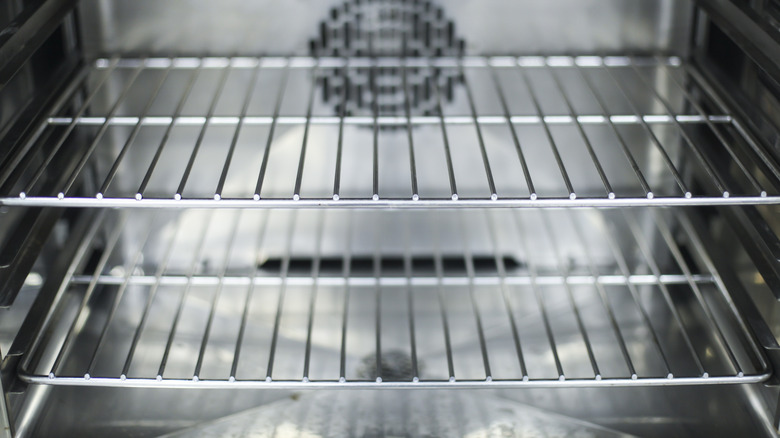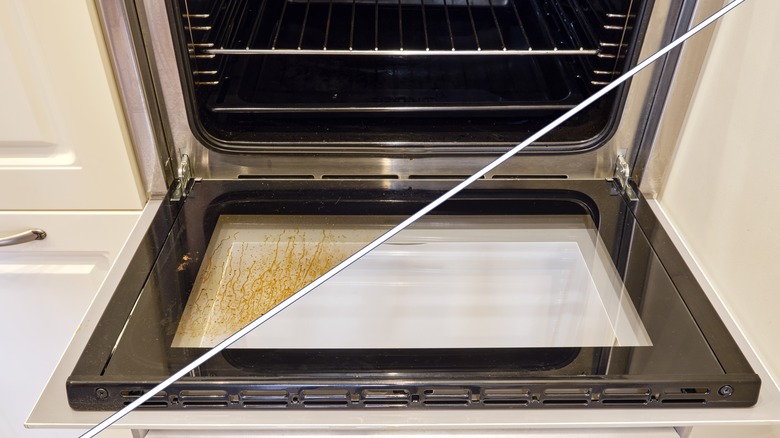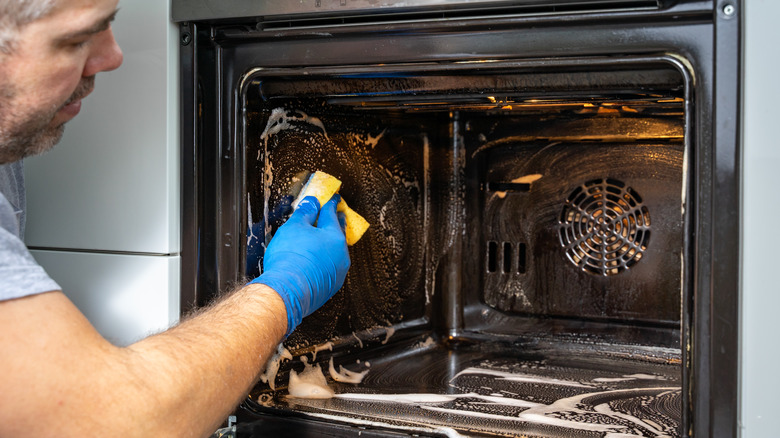Relying On Your Oven To Clean Itself Is A Big Mistake
As much as you might wish they would, household chores won't do themselves — not usually, anyway. Unlike most gadgets and appliances in your home, there's a good chance your oven has a self-cleaning feature. Since the first self-cleaning ovens were released in the early 1960s, it's become a near-universal function of both gas and electric ovens. And while the appeal is clear, there are some serious downsides that could come with using your oven's self-cleaning function.
There are two kinds of self-cleaning mechanisms: steam and high heat. Steam-cleaning ovens require you to pour about a cup of distilled water onto the oven's floor, then activate cleaning mode, which heats the oven to around 250 degrees Fahrenheit for somewhere around 30 to 60 minutes, producing steam that helps lift food debris so you can more easily wipe it away afterward. High-heat ovens, on the other hand, rise to a temperature of 800 to 1,000 degrees Fahrenheit — sometimes higher — for a period of four to six hours, effectively burning off any residue inside the oven.
The high-heat function saves you some manual labor, turning debris into ash that can be easily wiped away, whereas steam-cleaning loosens debris but will usually require a good scrub afterward to actually remove it. Unfortunately, though, the extreme heat generated by high-heat self-cleaning ovens can actually result in serious mechanical damage to the oven itself.
High heat can pop fuses and damage controls
In the course of normal cooking and baking, your oven generally doesn't need to go higher than 500 degrees Fahrenheit. When it self-cleans, however, it maintains a temperature hundreds of degrees hotter than that for several hours at a time, which, inconveniently, can damage the machine itself. And if you think your oven is in the clear because it's shiny and new, think again.
Newer ovens are actually more vulnerable to breaking due to self-cleaning, because the heating elements are typically concealed beneath the oven's floor and above its ceiling. On a day-to-day basis, this is a good thing — you don't need to worry about sauce dripping out of your lasagna pan onto direct heat and smoking up the kitchen. But as a side effect, the heat doesn't ventilate as easily and parts of the oven, like the fuses, thermostat, touch panel, wires, and locking mechanism, can end up overheating to the point of breakage. That can easily add up to hundreds of dollars in repair costs.
Because of this, appliance repair experts typically advise people to run their oven's self-cleaning function just once a year, if ever.
Alternatives to letting your oven clean itself
In general, always follow the manufacturer's instructions for cleaning kitchen appliances. But to be abundantly cautious, consider skipping the self-cleaning function altogether. Inconvenient though it is, the best way to clean your oven might just be the old-fashioned way: a generous amount of elbow grease.
There are plenty of commercially available kitchen cleaning products, but you may want to steer clear. While the products are typically pretty good at loosening and dissolving stuck-on food and debris, they're also prone to cause irritation — or worse — if they come into contact with soft tissue, including the mouth, eyes, skin, or any airway. You might even find the harsh chemical scent off-putting.
As a non-toxic alternative, try using just regular old baking soda and water. For regular maintenance cleanings, make a paste that's about 3 parts baking soda to every 1 part warm water. Coat the interior of your oven with the paste (avoiding the heating elements, if they're exposed) and spritz with vinegar, if desired, for some extra residue-lifting power. Let sit for 15 to 20 minutes before wiping all the baking soda — and the gunk it loosened — away with wet paper towels. For gnarlier situations, you may want to let the paste sit overnight to really work its way into tough spots. Wash the racks separately, in the sink with dish soap. Et voilà, you'll have a clean oven — no burning eyes or extreme heat required.


